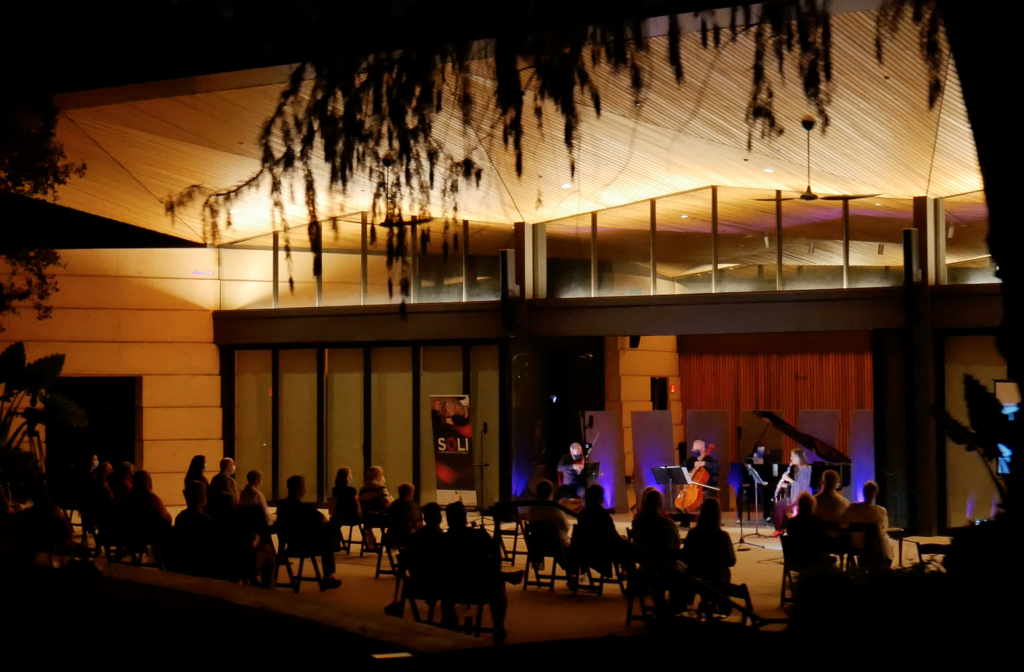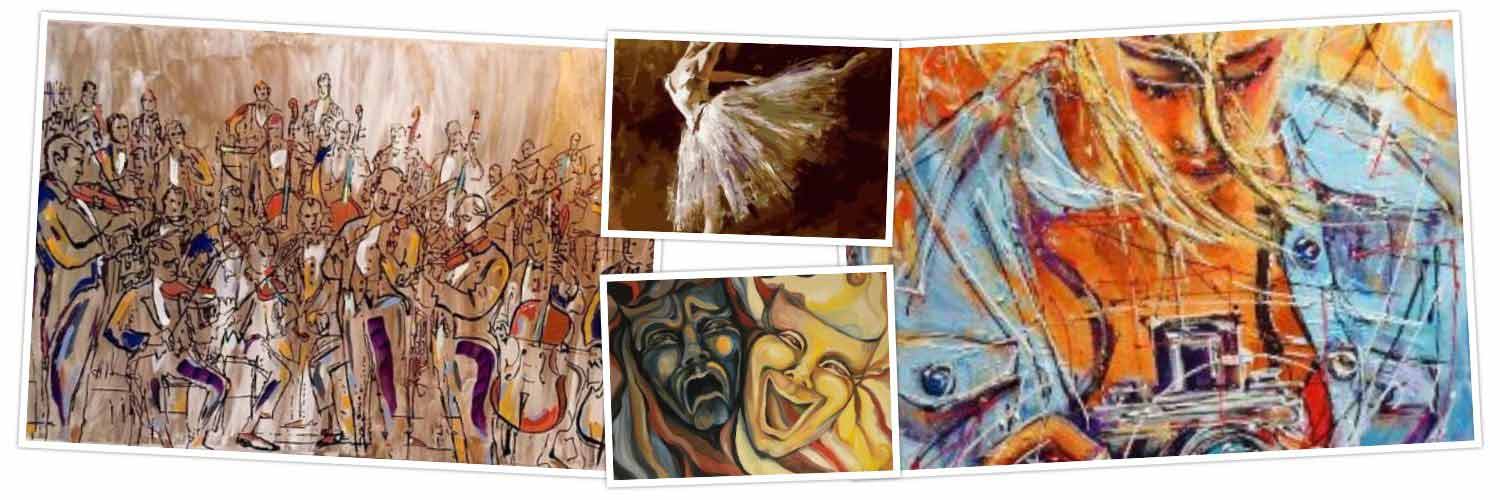Botanical Garden Is New Venue for Performing Arts
By JULIE CATALANO, Contributor —
They say nature abhors a vacuum. But sometimes nature fills a vacuum, as is the case at the popular, and award-winning San Antonio Botanical Garden, commemorating its 40th anniversary this year.
The Garden has something new to celebrate—turning into a hot spot for performing arts in the midst of a pandemic, when the great (and safer) outdoors beckons COVID-weary arts patrons to come and enjoy a live, in-person performance for the first time, it seems, in forever.
Two well-known local companies, The Classic Theatre of San Antonio and the SOLI Chamber Ensemble, recently entertained audiences in the Botanical Garden’s bucolic setting.
SABOT’s Chief Executive Officer Sabina Carr explained how this happy partnership with the arts came about: “While experiencing this crisis, I wanted the Botanical Garden to offer an outdoor home for the performing arts, to offer the community a space where they can safely physically distance while enjoying arts and cultural offerings.”

What followed was a sort of artistic domino effect. The Garden approached the San Antonio Symphony in early summer about the possibility of hosting the symphony or its chamber groups on its premises. Then, while waiting to hear from SAS, it was contacted by the Classic Theatre inquiring about using it as a venue for their plays. And before they even finalized the details with the Classic, the SOLI Chamber Ensemble, responded to the Garden’s initial offer to host a concert.
So, the stage was set for some delightful experiences of watching live theater and virtuosic music surrounded by nature, without worrying about catching COVID from people normally packed in tight rows inside a theater.
“With 38 acres of nature space, the Botanical Garden is the perfect outdoor setting offering wide open spaces and fresh air, including the Betty Kelso Center which is an indoor/outdoor venue with sliding glass doors and a patio that overlooks the Greehey Lawn,” said Katie Erickson, SABOT’s director of programs.
SOLI Managing Director Anne Schelleng was the first to “scout” the Kelso Center, where the professional quartet plans to hold all of its 2020-2021 live concerts. She was impressed with the safety protocols already in place, requiring masks and social distancing, and no printed programs.
“It’s a beautiful space,” said Schelleng of the Kelso Center. “Because of the size we were able to create a small audience seating area on the large patio, masked and socially distanced from the musicians, also masked. The chairs sold out. On the lawn, which was close to selling out, ‘pods’ were staked out for audiences to park their blankets or their own lawn chairs, whatever they brought, at safe distances from other pods.”

The SOLI is a unique chamber group in San Antonio because they perform only “new music,” meaning works by contemporary, mostly living composers. Consisting of SAS members- Stephanie Key (clarinet), Ertan Torgul (violin), David Mollenauer (cello) and Carolyn True (piano) – the ensemble has established a sterling reputation both here and nationally.
Pianist True, a 27-year veteran of SOLI, said she was grateful “that there was a space where we could do this safely. We were missing making music together. That performance was the first we had given in eight months.” Adapting to the new setup called for some ingenuity.
True and the piano were actually on the inside of the Kelso Center, behind the line where the glass wall would have been if not retracted. In addition to the overhang above the musicians that provided an acoustical shell-like structure. True credits Schelleng for an excellent on-the-spot brainstorm that improved the situation. “What you see behind the piano are tables standing on end,” she explained, “Anne came up with a brilliant idea for a DIY acoustical shell because the building is very deep and without those tables, it was just me and this big expanse. When she put those tables up it gave much more direct shooting of the sound back out into the audience.”
All in all, True considers the night a success. “It was a lovely night. The Botanical Garden is wonderful. We had a great turnout.” Schelling concurs, giving credit to SABOT for “facilitating our planning effort and working through logistics and being extremely supportive and helpful.”
The Garden turned out to be savior for The Classic Theatre, too. When Executive and Artistic Director Kelly Roush realized that COVID-19 “was a disruption as opposed to an interruption,” as she first assumed, she tried to find new ways to fulfill her company’s mission. “Okay, we are committed to live theatre. Now what?” was her fundamental question. With performances at the Classic’s tiny black box theatre on Woodlawn out of the question (“10% capacity would have given us 10 people in the audience,” she noted), Roush began looking around—and out. As in, outdoors. “Outdoors is safer, and Shakespeare and the Greeks did it. What might this look like?” She wondered.
Since the Botanical Garden was a longtime family favorite, Roush eventually also connected with Erickson. “The Garden was already open and doing things really safely,” said Roush. She chose to present Macbeth, Shakespeare’s shortest tragedy, which the Classic’s team had to cut down further to make the play fit into a roughly two-hour-fifteen-minute performance with one intermission. By all accounts, it was a resounding success.
Roush considered the garden setting perfect for the tale of ambition, political intrigue, spies, witches, and murder. She and her crew of artists, designers and tech people navigated and maneuvered a million moving parts to stage six evening performances at the Botanical Garden (plus six more at the Espee.) The actors went from a Zoom meeting and one-on-one Zoom rehearsals to being out in a park with one director/one actor and one director/two actors at a time, all socially distanced and masked at all times. Five days before opening they began rehearsing at the Botanical Garden amphitheater, “with an arbor and stone structures, stone pillars, grass-covered stone steps, and loads of atmosphere.”
The company kept its audience at 99—about the same capacity as their brick-and-mortar theatre—even though the audience capacity was around 500. Every show sold out. “We could spread out. We had all this space for social distance,” said Roush. For the staging itself, “we put all 10 actors on kind of a track. Working on their comings and goings was almost like dance choreography, mask on—unless you’re six feet apart or speaking in the moment.” Actors were also at least 10 feet from the audience.
“Katie staked out ground pods at seven to eight feet apart, people brought their own blankets or chairs. We tried to keep pods at three or four people maximum. People were amazing. A family of six had three in one pod and three in another,”she noted. Almost every actor, except the leads of Macbeth and Lady Macbeth, played several roles, with one intrepid soul tackling six roles every show.
With no dressing rooms, the actors dressed at home in all black—tee-shirts, pants and boots, with their costume pieces and props (plaids, crowns, swords, more plaids) in a big gray bin that each actor took home every night. No borrowing or leaving things behind. Everybody had their hair braided “in very Scottish Braveheart-esque” style.
“Every night we’d learn something new” she explained, “although some things, like chirping birds and a curious resident toad, were dependable garden inhabitants. The full October moon was stagecraft no money could buy. In a year when you can’t make anything happen, much less happen well, there was magic. Nature sounds, trees, an overhang of shadows where characters appear and disappear.”
She described the audiences as excitingly diverse, and everybody seemed happy just to be out and seeing each other.
Roush is optimistic about “embracing wonderful unexpected opportunities” such as the company just had at SABOT. “Amidst all of the feelings of riding the rapids or getting knocked off center, there’s so much joy in getting to work creatively at this time,” she observed. Some of her favorite audience feedback came from a patron who told her “We had such a good time and felt safe, because we could tell how safe the actors were being and how safe they felt.”
Erickson added that the performances “bring a new kind of life to our garden spaces. They help people connect with nature in new ways, and they are a safe way to provide social opportunities. It is healing for our audiences and our community.”
—————————-
SOLI’s upcoming concerts: “Electrified Air,” Feb. 21, 2021; “Contemporary Open Mic Night,” Feb. 28, 2021 and “Stories from the Voices Within,” April 25, 2021; www.solichamberensemble.com
Upcoming Classic Theatre productions are: “Our Town,” Feb. 5-28, 2021; and “Antigone,” April 8-May 2, 2021; www.classictheatre.org
Other groups that performed at SABOT include the Magik Theatre, Symphony VIVA and Taiko Drum Performance by Isaku Kageyama.
For more information on live performances: www.sabot.org; 830-302-8162

What a great story. Thank you